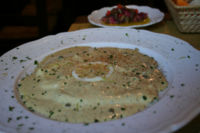Vitello tonnato: Difference between revisions
imported>Hayford Peirce m (moved a comma) |
imported>Stephen Ewen (Commenting out image as Constabulary action.) |
||
| Line 1: | Line 1: | ||
[[Image:Vitello_tonnato_1.jpg|thumb|left|200px|A very elegant presentation of Vitello tonnato]] | <!-- CONSTABULARY ACTION. COMMENT OUT IMAGE BECAUSE OF LICENSING ISSUE. [[Image:Vitello_tonnato_1.jpg|thumb|left|200px|A very elegant presentation of Vitello tonnato]]--> | ||
[[Image:Vitello_tonnato_2.jpg|thumb|right|200px|Vitello tonnato, chilled, sliced veal with tuna fish sauce]] | [[Image:Vitello_tonnato_2.jpg|thumb|right|200px|Vitello tonnato, chilled, sliced veal with tuna fish sauce]] | ||
Revision as of 00:44, 3 July 2007
Vitello tonnato is a well-known Italian dish of cold, sliced veal covered with a creamy, mayonnaise-like sauce that has been flavored with tuna fish. It is served chilled or at room temperature,[1] generally in the summertime, as the main course of an Italian meal or as "an exceedingly elegant antipasto for an elaborate dinner."[2] It is prepared at least a day or more in advance by braising or simmering a large piece of veal, which is then cut into thin, individual servings. The sauce is also made in advance. Tuna fish, which can be of the canned variety, is puréed in an electric blender or food processor with olive oil and a variety of seasonings including anchovies, egg yolks, cayenne pepper, and lemon juice. This thick, smooth purée is then somewhat thinned with a little cream and cooking liquid from the veal and a few capers are stirred in. Some of the sauce is spread out on a serving platter and the cold slices of veal are arranged in a single layer on top. The rest of the sauce is then poured over the veal so that it is, generally, completely covered. The dish is allowed to refrigerate for a period up to a week to fully develop the flavor.[3] When served, vitello tonnato can be garnished with such things as cold wedges of tomato and hard-boiled eggs. For a less expensive version, turkey breast or pork loin can be substituted for the veal.[4]
References
- ↑ *Essentials of Classic Italian Cooking, by Marcella Hazan, Alfred A. Knopf, New York, 1992, page 382
- ↑ *Essentials of Classic Italian Cooking, by Marcella Hazan, Alfred A. Knopf, New York, 1992, page 384
- ↑ *Essentials of Classic Italian Cooking, by Marcella Hazan, Alfred A. Knopf, New York, 1992, page 384
- ↑ *Essentials of Classic Italian Cooking, by Marcella Hazan, Alfred A. Knopf, New York, 1992, page 382
Sources
- Essentials of Classic Italian Cooking, by Marcella Hazan, Alfred A. Knopf, New York, 1992
- Michael Field's Culinary Classics and Improvisations, by Michael Field, Alfred A. Knopf, New York, 1967, pages 67-68
